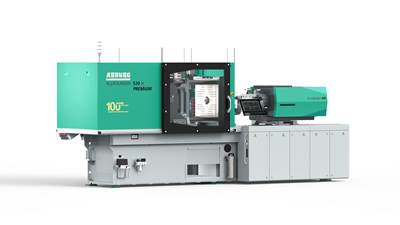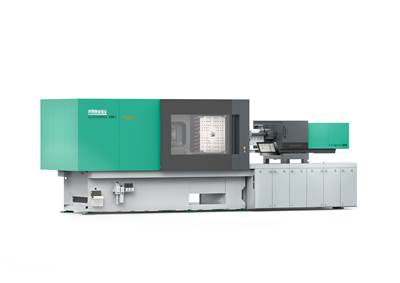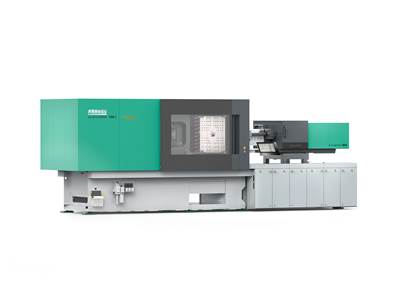Arburg Debuts New Machine Outside of Germany for First Time
NPE2024: Arburg says the Allrounder 720 E injection molding machine premiere highlights the importance of the show and market.
Share
Historically, machine premieres for Arburg have been a German affair, occurring at the K, Fakuma or the company’s global headquarters in Lossburg. That is no longer exclusively the case. Visitors to Arburg’s booth can see the new Allrounder 720 E Golden Electric machine for the first time anywhere here in Orlando. Arburg USA President Martin Baumann says that divergence from tradition was no accident.
“The Allrounder 720 E premiere highlights how important the show and the market are,” Baumann says, noting that the company has an installed machine base in the U.S. in excess of 14,000. “Arburg has had a large presence here for many, many years and, from a market perspective, it highlights that our business, which has always been an international company, takes that status very seriously.”
While the debut is big, the press itself, is smaller. “We have significantly slimmed the machine down,” Baumann says, noting that it is just 6 feet wide but adding that the smaller footprint does not equate to diminished capabilities. Baumann notes that, in general, Arburg sells more all-electric machines in the U.S. than hydraulics, further justifying the NPE unveiling for the machine with servo-electrically driven injection/metering and mold opening/closing.
Trendwise, the company sees more interest in the medical market broadly and higher cavitation tools specifically, with many of these tools utilizing side actions, impacting required platen size. “The applications don’t have a huge shot weight,” Baumann says. “Many small parts are molded from a small shot size unit, but the need for a large platen is becoming more important.”
Baumann compares Arburg’s approach to shrinking the Golden Electric’s footprint to an aircraft maker trying to reduce the mass of a seat, for instance, investigating every possible reduction without impacting comfort and performance. “One key thing is the clamp fundamentally hasn’t been changed from a principal point of view,” Baumann says. “It’s what comes after the clamp: oil pumps, water connections, everything around the machine after the clamp, that’s what’s been optimized.” One example is the safety door handle, which is now recessed into the door. “Now the handle is recessed where previously it stuck out,” Baumann says. “That’s three inches — all these details add up.”
Filling the Skills Gap
Much of Arburg’s booth display and its technologies in general seek aid molders struggling to find workers. “I talk to a lot of customers,” Baumann says, “and we do have big skills-gap issues in the U.S. in injection molding. As a machine supplier, we build more and more intelligence into the press with assistants and helpers.” This even includes actions like scheduling on shop floor, with all these assistants informed by Arburg’s deep knowledge of molding. “What differentiates us from a pure software company,” Baumann says, “is we come from injection molding. Scheduling, mold changes, processing, all the little things — we understand them on a different level.”
In addition to digital assistants, Arburg also understands the importance of real-world robotic assistants, with automation as a key element to its solution for the worker shortage problem. “Every system at the show has automation,” Baumann says. “There are no free-falling parts. This is definitely a key trend — not just in the U.S. but it is particularly acute here. Unemployment is at 3.6%, and a lot of customers can’t find people. We have the resources and the know-how, including engineers in the U.S., to act as local sources for automation.” Baumann notes that between the headquarters in Connecticut and tech centers in Illinois and California, Arburg also has the space and machines to prove out complex automation cells prior to delivery. “We don’t have to interrupt processes,” Baumann says. “We can do it offsite and make space available for them.”

Arburg USA President Martin Baumann. Source: Arburg
Related Content
Back to Basics on Mold Venting (Part 1)
Here’s what you need to know to improve the quality of your parts and to protect your molds.
Read MoreUsing Data to Pinpoint Cosmetic Defect Causes in Injection Molded Parts
Taking a step back and identifying the root cause of a cosmetic flaw can help molders focus on what corrective actions need to be taken.
Read MoreProcess Monitoring or Production Monitoring—Why Not Both?
Molders looking to both monitor an injection molding process effectively and manage production can definitely do both with tools available today, but the question is how best to tackle these twin challenges.
Read MoreA Systematic Approach to Process Development
The path to a no-baby-sitting injection molding process is paved with data and can be found by following certain steps.
Read MoreRead Next
Fakuma 2023: Arburg Extends Hybrid Range, Introduces New Service
Arburg will have nine exhibits on its own stand and another 10 machines on partner stands with live demonstrations of applications, processes and trends in injection molding and 3D printing.
Read MoreU.S. Debut for Slimmed Down Electric Machine
NPE2024: Arburg’s debut of the 310-ton Allrounder 720 E Golden Electric extends the tonnage range of the electric series and marks the first global press premiere outside of Germany.
Read MoreAll-Electric Press Gets U.S. Debut
NPE2024: For the first time, Arburg is making a global premier of a machine outside Germany with the new Allrounder 720 E Golden Electric among its 13 exhibits — seven in its own booth — in Orlando.
Read More
















